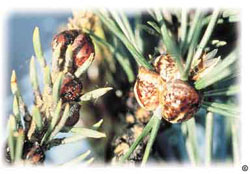Many important scale-insect pests affect pines in Colorado. Scales usually are seen in the stationary stage as adults and aren’t always correctly identified.
Scales can be observed on bark and needle s. They feed by sucking sap from a tree. The tree suffers reduced vigor, needle drop and dieback in severe infestations. Some scales also excrete a sticky honeydew that attracts nuisance pests such as yellow jackets and other wasps.
s. They feed by sucking sap from a tree. The tree suffers reduced vigor, needle drop and dieback in severe infestations. Some scales also excrete a sticky honeydew that attracts nuisance pests such as yellow jackets and other wasps.
In Colorado, the pine-needle scale and striped-pine scale are the most serious pests. Other scales that cause damage to a lesser degree include the black-pineleaf scale, juniper scale, pine-tortoise scale and pinon-needle scale.
All scales start as eggs that are laid underneath the mother scale. When eggs hatch, the young scales or “crawlers” are mobile and are dispersed by crawling or wind or are carried on the bodies of birds. Crawlers eventually settle on a tree, produce a waxy covering and settle in to feed.
The crawler stage usually occurs from mid- to late spring and lasts one to two weeks. Control of scale is best targeted against the crawler stage. There are many insecticide options including soaps, oils, Sevin, permethrin, Orthene and cyfluthrin.
For more information, see the following Colorado State University Extension fact sheet(s).



